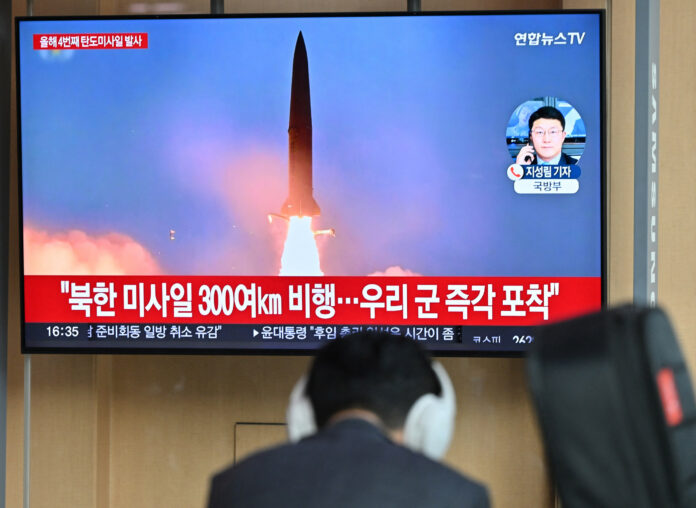North Korea fired multiple ballistic missiles off its east coast on Monday, the South said, in what was Kim Jong Un’s latest show of force in the neighborhood.
A Newsweek map, based on geographic data released by Japan, shows the approximated launch trajectory toward the east of the Korean Peninsula.
South Korea’s Joint Chiefs of Staff detected several short-range ballistic missiles launched from neighboring capital Pyongyang at 3:01 p.m. local time. The projectiles flew about 185 miles and “splashed into the sea,” according to a statement carried by the country’s Yonhap news agency.
Seoul condemned North Korea’s missile test—at least its fourth ballistic launch event of the year so far—but did not provide further details on the model of the weapon fired into the East Sea, also known as the Sea of Japan.
Inter-Korean relations are at a low point not seen in decades, fuelled by the North’s weapons tests and war talk, which its official Korean Central News Agency says are a response to the South’s alignment with the United States, considered a threat to its national security.
The North’s KCNA said on Friday that the regime tested a new “super-large warhead,” thought to be designed for a nuclear-capable strategic cruise missile. However, Pyongyang has yet to acknowledge the latest test.
The North Korean Embassy in Beijing did not immediately respond to a written request for comment.
JUNG YEON-JE/AFP via Getty Images
Around the time of South Korea’s notification, Japan’s Defense Ministry said separately that it had tracked the trajectory of at least one ballistic missile.
Tokyo said it reached an altitude of about 30 miles and travelled 155 miles before landing in the Sea of Japan, outside of Japan’s exclusive economic waters.
Minoru Kihara, the Japanese defense minister, ordered the collection and analysis of missile data to be shared with the U.S. and South Korea, the ministry’s statement said.
Since December, the three allies have jointly monitored North Korean launch events with a new real-time data-sharing mechanism.
Pyongyang’s repeated missile tests “threaten the peace and security of Japan, the region and the international community,” Japan’s Defense Ministry said, noting that Kim’s government was also violating several U.N. Security Council resolutions.
The Hawaii-based U.S. Indo-Pacific Command did not respond to a request for comment.
Since coming to power in 2012, Kim has overseen four nuclear tests and at least 179 known launches of various types of missiles, Japan’s Defense Ministry said in its March fact sheet.
Long-time North Korea watchers believe Kim could be willing to risk a limited conflict with the South or significantly ramp up his saber-rattling in order to extract concessions from the U.S. in a presidential election year.
Experts do not rule out the possibility of Kim timing his next nuclear test—his fifth and the country’s seventh overall—to coincide with the run-up to the American vote.
Separately, South Korea says it is monitoring a possible satellite launch by the North, which it believes to be in planning although not imminent.
Intelligence assessments by Seoul have concluded that Pyongyang’s space program has help from the Kremlin, with North Korea allegedly supplying weapons to Russia for use in its war against Ukraine.
Both North Korea and Russia deny trading arms.
Uncommon Knowledge
Newsweek is committed to challenging conventional wisdom and finding connections in the search for common ground.
Newsweek is committed to challenging conventional wisdom and finding connections in the search for common ground.


